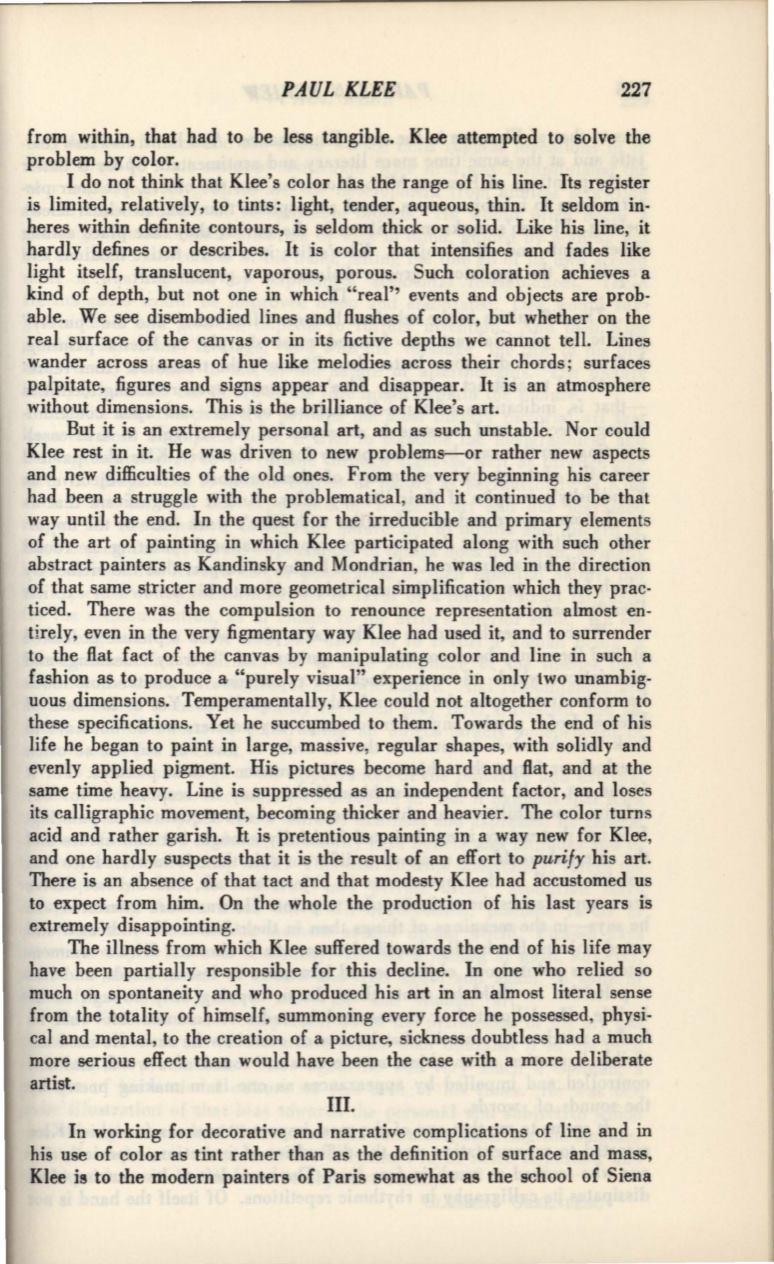
PAUL KLEE
227
from within, that had to be less tangible. Klee attempted to solve the
problem by color.
I do not think that Klee's color has the range of his line. Its register
is limited, relatively, to tints: light, tender, aqueous, thin. It seldom in·
heres within definite contours, is seldom thick or solid. Like his line, it
hardly defines or describes. It is color that intensifies and fades like
light itself, translucent, vaporous, porous. Such coloration achieves a
kind of depth, but not one in which "real'' events and objects are prob·
able. We see disembodied lines and flushes of color, but whether on the
real surface of the canvas or in its fictive depths we cannot tell. Lines
wander across areas of hue like melodies across their chords; surfaces
palpitate, figures and signs appear and disappear. It is an atmosphere
without dimensions. This is the brilliance of Klee's art.
But it is an extremely personal art, and as such unstable. Nor could
Klee rest in it. He was driven to new problems-or rather new aspects
and new difficulties of the old ones. From the very beginning his career
had been a struggle with the problematical, and it continued to be that
way until the end. In the quest for the irreducible and primary elements
of the art of painting in which Klee participated along with such other
abstract painters as Kandinsky and Mondrian, he was led in the direction
of that same stricter and more geometrical simplification which they prac–
ticed. There was the compulsion to renounce representation almost en–
tirely, even in the very figmentary way Klee had used it, and to surrender
to the flat fact of the canvas by manipulating color and line in such a
fashion as to produce a "purely visual" experience in only two unambig–
uous dimensions. Temperamentally, Klee could not altogether conform to
these specifications. Yet he succumbed to them. Towards the end of his
life he began to paint in large, massive, regular shapes, with solidly and
evenly applied pigment. His pictures become hard and flat, and at the
same time heavy. Line is suppressed as an independent factor, and loses
its calligraphic movement, becoming thicker and heavier. The color turns
acid and rather garish.
It
is pretentious painting in a way new for Klee,
and one hardly suspects that it is the result of an effort to
purify
his art.
There is an absence of that tact and that modesty Klee had accustomed us
to expect from him. On the whole the production of his last years is
extremely disappointing.
The illness from which Klee suffered towards the end of his life may
have been partially responsible for this decline. In one who relied so
much on spontaneity and who produced his art in an almost literal sense
from the totality of himself, summoning every force he possessed, physi–
cal and mental, to the creation of a picture, sickness doubtless had a much
more serious effect than would have been the case with a more deliberate
artist.
III.
In working for decorative and narrative complications of line and in
his use of color as tint rather tha.n as the definition of surface and mass,
Klee is to the modern painters of Paris somewhat as the school of Siena


